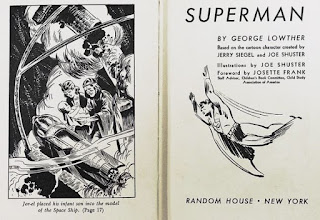Each Friday, I take one of the entries from my old
Super Posts and expand it into its own featured article.
This week: Kal-El's name (and Kal-L's)!
Everyone knows Superman debuted in
Action Comics #1 (April 1938), and that's where his origin was told for the first time. What many people don't realize is how bare-bones the origin was at the time. A scientist on a dying planet sent his infant son into space, where he landed on Earth, grew up as Clark Kent, and used his superpowers as Superman.
All of that is still accurate today, but it's missing a lot of detail. Luckily, Superman became very popular very quickly, so in January 1939, a
Superman comic strip started - which, incidentally, was Jerry Siegel and Joe Shuster's preferred format for Superman in the first place (the first Superman story was simply the first 38 strips they had produced when they were shopping the character around). This new strip allowed them a do-over, so it started with a more detailed origin, where we learn the baby's name is Kal-L in the first strip ("Superman Comes to Earth").
Superman's origin was re-told again when he got his own series (Superman #1, April 1939), but it didn't include the baby's Kryptonian name.
Soon after, Superman got a radio adaptation and one of the radio show's writers, George Lowther, wrote a book called The Adventures of Superman (1942). In this re-telling of his origin, his name is spelled "Kal-el" for the first time. I couldn't find proof of that, but here is an image from the book of "Jor-el" being spelled the same way.
Surprisingly, the spelling "Kal-El" (with or without a capital) wouldn't appear in comics until Superman #113 (March 1957).
Over time, it was established that one of the differences between Earth-One and Earth-Two is Kryptonian naming conventions, with Earth-One using "-El" and Earth-Two using "-L". The name "Kal-L" would appear as the birthname of the Superman of Earth-Two in
Action Comics #484 (April 1978).
In the New 52, the primary Earth's Superman is still called Kal-El, but Earth-2's Superman is
also called Kal-El. However, the Pre-Crisis Earth-Two's Superman is still known as Kal-L when he appears (such as in
Convergence: Action Comics #1, April 2015).
































